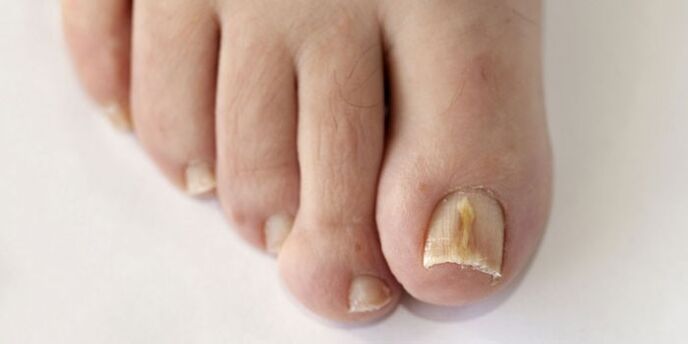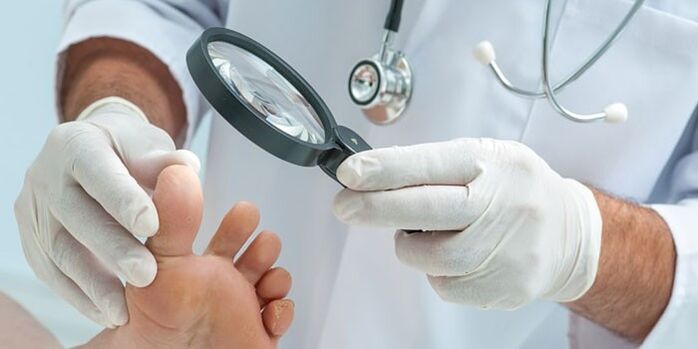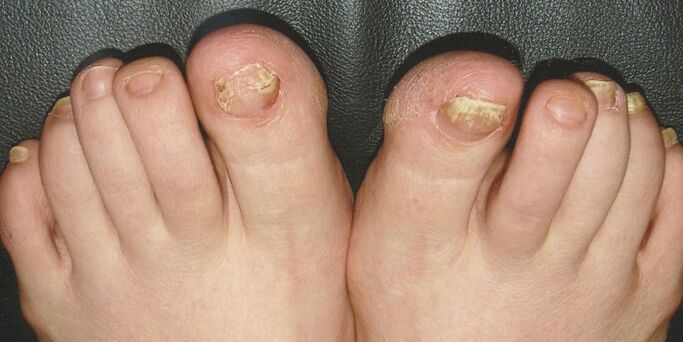Many do not even suspect that sweating, an unpleasant odor pursues them due to onychomycosis.It is an insidious disease, whose therapy takes a long time and does not always bring a hundred percent result.For effective treatment of the disease, it is necessary to identify the signs of fungus of the nails as quickly as possible, which apply on the nail plate, foot and legs.
What is nail fungus
An infectious disease caused by mold mushrooms and yeast of the genus Candida is called onychomycosis.According to WHO statistics, from 5 to 15% of the globe population suffers from the disease.Microorganisms affect the nail plate, changing its color, shape and hardness.Dermatologists note frequent cases of diseases in adults and children.With poorly selected treatment, serious complications can occur, up to gangrene.
The infection occurs due to the non-compliance of personal hygiene rules, high humidity in baths and saunas and mechanical injuries.Regular contact with detergents, water causes the development of the disease.The flat feet and the narrow differences between the fingers increase the risk of the disease.The fungus manifests itself more often in people with a weakened immune system, then other organs are also infected with a fungal infection.

What the fungus looks like on the legs
If you are interested in how to determine the fungus on the legs of the legs, look at the edge free and the plate of the mouth at your fingertips.With a dating of the disease of the disease, the nail becomes a yellow shade and the plate is not transparent.The second degree of pathology is characterized by hyperkeratosis.The disease is manifested by the keratinization of the nail bed, which becomes much thicker than a healthy organ.The last step is characterized by dystrophy, the defeat of the matrix.
Symptoms
Few people pay attention to the initial symptoms of onychomycosis.The sooner you will notice the disease, the more effective the treatment will be.Nail fungus symptoms:
- change in the integrity of the nail;
- Change in the color of the plate;
- Relax the nail phalanx;
- The pain resulting from pathology develops;
- Skin itching, burning around the affected area.
White plaque on the nails
The appearance of white spots is one of the first signs of nail mushrooms on the legs.A plate may look like round spots of different sizes, longitudinal scratches or cover the whole bed with the nail.If you notice changes in the surface of the mouth at the end of your fingers, consult a doctor urgently, self-medication can cause negative consequences for your health.
Signs
The disease causes several types of pathogens that manifest themselves in different ways.Depending on the nature of the microorganism, the signs of the fungus on the legs of the legs will differ:
- Yeast.With this type of pathogen, the disease can be recognized after a long time.The coat appears, but itching of the skin near the affected area can be absent.
- Mold.It occurs in 1% of patients, most often develop in patients with HIV infection.
- Dermatophytes.The most common causal agent of the disease that causes the nail plate tightening, its delays.The pathogenic organism also affects legs and feet, can spread to interdigital folds.In most cases, an inch and a little finger is surprised.

The first signs
Most people do not notice how the fungus begins.Symptoms appear when most of the nail plate is damaged.Almost immediately, infection can only be visible in the footsteps.Between the fingers are starting to be ashamed and peeling the skin, itching occurs.Little by little, a deeper lesion of the skin occurs, until the formation of cracks.An important sign from the start of the disease is a change in color and structure of the plate.It becomes fragile, is constantly damaged, which causes significant pain.
How different types of onychomycosis are manifested
This lower limb disease does not have a single clinical picture.The way in which the fungus of the nails manifests on the legs depends on the type of disease.To obtain the maximum result of the treatment, doctors distinguish the following varieties of the fungus:
- Normotorophic.At the start of the disease, the color of the disease plaque changes, while the thickness and natural sparkle remain unchanged.On the side parts of the plate, there are yellow or white spots, scratches.Gradually, the nail completely changes color, but its thickness remains normal.With this form of the disease, onycholysis is observed - the impossibility of a plate to develop in the bed of the nail.
- Hypertrophic.This type of disease is diagnosed by thickening the plate.The scales are starting to grow under the nail.The plate fades, begins to break, the color becomes gray or dark yellow.A person may feel pain when walking.
- Atrophic.With this type of disease, a change in the color of the brown gray plate is characteristic.The nail loses shine, the plate is gradually destroyed.The last step in this type of onychomycosis is manifested by the complete destruction of the nail bed, its necrosis.Atrophy occurs at the outer end to the growth area.
Treatment
The modern pharmaceutical industry offers many means for the treatment of fungi.Local and general drugs are used.Only a specialist can choose drugs after a series of tests.Before prescribing the medication, at the rendezvous, the doctor assesses the following factors of the disease:
- Duration of the disease;
- zone of inflammation;
- the nature of pathological changes;
- the presence of other pathologies.
If the disease is at an advanced stage or develops very quickly, antibiotics should be used for treatment.Dysbiosis treatment tablets cannot be taken with liver or renal pathologies, children.Before you start treatment, you must familiarize yourself carefully with the pharmacological compatibility of the drugs taken.
Often used products that should be applied directly to the affected nail.It is recommended to pre-work the skin with hydrogen peroxide or alcohol.To completely eliminate pathogenic microbes, disinfectant sprays for shoes should be used.The course of treatment takes several months.

















